

Photovoltaic (PV) cells convert radiation from the sun into electricity. A
typical PV cell consists of a wafer of semi-conducting material, usually
silicon, manufactured with two electrically different layers. When
sunlight hits the cell it excites the electrons within the silicon, creating
an electric field across the layers and causing a flow of electricity.
1. The Solar PV modules are mounted to the roof.
2. During the day the PV cells within the modules convert sunlight into
DC (Direct Current) electricity.
3. The DC electricity enters the inverter which converts the DC
electricity in to AC (Alternating Current) electricity.
4. The AC electricity is then sent to the main distribution board for use
in the building.
5. When more electricity is generated than is required by the house,
the excess electricity will be ‘spilled' in to the local electricity grid.
The solution comprises of 3 main pieces of equipment: The Solar PV
array, the inverter (the size of a shoe box which is normally placed in
the loft), and a visual display to monitor how much electricity is being
generated.
The installation of a Solar PV system usually takes 1-3 days. It
consists of:
a) Removing the necessary tiles/slates/other
b) Fitting the railing
c) Bolting the array to the railing
d) Installing the inverter
e) Installing the fuse switch off
f) Setting up visual display
g) Cabling and wiring
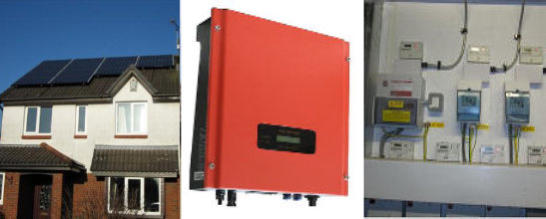
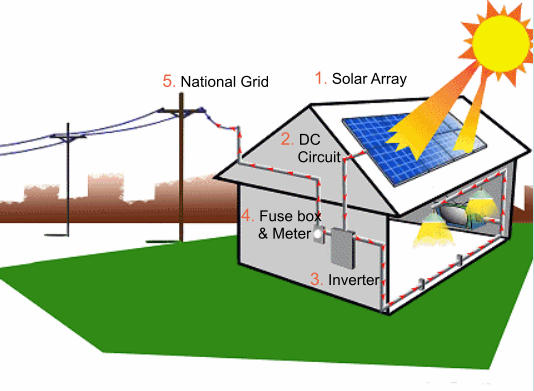
Solar PV Basics
1. Solar Array
3. Inverter
4. Fuse box
& Meter



Photovoltaic (PV) cells convert radiation from the
sun into electricity. A typical PV cell consists of a
wafer of semi-conducting material, usually silicon,
manufactured with two electrically different layers.
When sunlight hits the cell it excites the electrons
within the silicon, creating an electric field across
the layers and causing a flow of electricity.
1. The Solar PV modules are mounted to the roof.
2. During the day the PV cells within the modules
convert sunlight into DC (Direct Current)
electricity.
3. The DC electricity enters the inverter which
converts the DC electricity in to AC (Alternating
Current) electricity.
4. The AC electricity is then sent to the main
distribution board for use in the building.
5. When more electricity is generated than is
required by the house, the excess electricity will
be ‘spilled' in to the local electricity grid.
The solution comprises of 3 main pieces of
equipment: The Solar PV array, the inverter (the
size of a shoe box which is normally placed in the
loft), and a visual display to monitor how much
electricity is being generated.
The installation of a Solar PV system usually
takes 1-3 days. It consists of:
a) Removing the necessary tiles/slates/other
b) Fitting the railing
c) Bolting the array to the railing
d) Installing the inverter
e) Installing the fuse switch off
f) Setting up visual display
g) Cabling and wiring

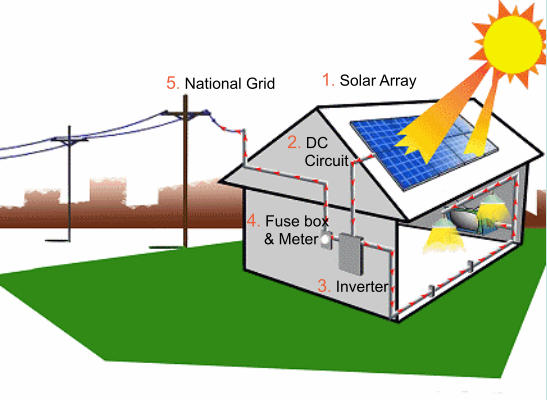
Solar PV Basics
1. Solar Array
3. Inverter
4. Fuse box
& Meter



Biomass Installer Yorkshire
Balcas Brites
Biomass Pellet Supplier
Biomass Boilers Yorkshire
Biomass Boilers
Biomass Yorkshire
MCS
AECB
Biomass Lancashire
Biomass Heating Yorkshire
Biomass Heating
Solar Heating
Biomass Boilers
Solar PV
Biomass heat Yorkshire
Fit Tarriffs
ASHP Yorkshire
ASHP Lancashire
GSHP Yorkshire
ASHP Lancashire


Solar PV Basics
Photovoltaic (PV) cells convert radiation from the sun into electricity. A
typical PV cell consists of a wafer of semi-conducting material, usually
silicon, manufactured with two electrically different layers. When sunlight
hits the cell it excites the electrons within the silicon, creating an electric
field across the layers and causing a flow of electricity.
1. The Solar PV modules are mounted to the roof.
2. During the day the PV cells within the modules convert sunlight into DC
(Direct Current) electricity.
3. The DC electricity enters the inverter which converts the DC electricity
in to AC (Alternating Current) electricity.
4. The AC electricity is then sent to the main distribution board for use in
the building.
5. When more electricity is generated than is required by the house, the
excess electricity will be ‘spilled' in to the local electricity grid.
The solution comprises of 3 main pieces of equipment: The Solar PV
array, the inverter (the size of a shoe box which is normally placed in the
loft), and a visual display to monitor how much electricity is being
generated.
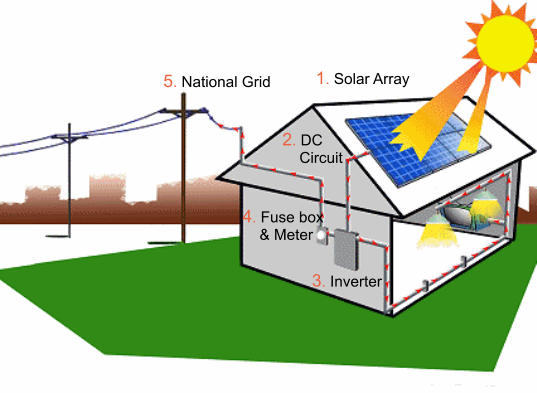
1. Solar Array
3. Inverter
4. Fuse box
& Meter



Photovoltaic (PV) cells convert radiation from the sun into
electricity. A typical PV cell consists of a wafer of semi-conducting
material, usually silicon, manufactured with two electrically
different layers. When sunlight hits the cell it excites the electrons
within the silicon, creating an electric field across the layers and
causing a flow of electricity.
1. The Solar PV modules are mounted to the roof.
2. During the day the PV cells within the modules convert
sunlight into DC (Direct Current) electricity.
3. The DC electricity enters the inverter which converts the DC
electricity in to AC (Alternating Current) electricity.
4. The AC electricity is then sent to the main distribution board for
use in the building.
5. When more electricity is generated than is required by the
house, the excess electricity will be ‘spilled' in to the local
electricity grid.
The solution comprises of 3 main pieces of equipment: The Solar
PV array, the inverter (the size of a shoe box which is normally
placed in the loft), and a visual display to monitor how much
electricity is being generated.
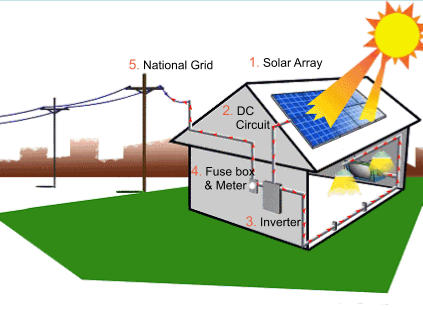
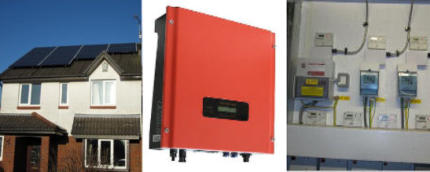
1. Solar Array
3. Inverter
4. Fuse box
& Meter



Tel: 01282 786900 Mob: 07790 215 065
© 2016 Reliable Renewables Ltd.

Solar PV

Tel: 01282 786900 Mob: 07790 215 065
© 2016 Reliable Renewables Ltd.
Solar PV

07790 215 065
© Copyright Reliable Renewables Ltd 2016
Tel:
01282 786900
Mob:
Solar PV
© Copyright Reliable Renewables Ltd 2016

Tel:
01282 786900
Mob:
07790 215 065
Solar PV
































